Contents
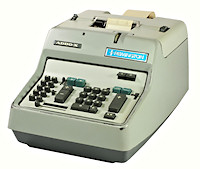
Contents |

|
| Addo-X Model 4653, 1966. |
 The Addo company of Malmo in Sweden was established in 1918 by Hugo
Agrell to manufacture a range of portable slide-set adding machines
of his own design. These were the Addo Models 1 to 5. A range of
substantial full-keyboard adding and listing machines, also
advertised as "portable", was added in 1926. Models 6 to 8 were
decimal machines, while the Models 9 and 10 found in Australia were
built for the British system of pounds, shillings, and pence
(£/s/d). The full-keyboard machines all shared the same case
and the same basic calculating mechanism.
The Addo company of Malmo in Sweden was established in 1918 by Hugo
Agrell to manufacture a range of portable slide-set adding machines
of his own design. These were the Addo Models 1 to 5. A range of
substantial full-keyboard adding and listing machines, also
advertised as "portable", was added in 1926. Models 6 to 8 were
decimal machines, while the Models 9 and 10 found in Australia were
built for the British system of pounds, shillings, and pence
(£/s/d). The full-keyboard machines all shared the same case
and the same basic calculating mechanism.
The full-keyboard machines were largely superseded by the ten-key "Addo X" from 1936, with the X representing a Roman 10. These gradually developed into a very broad range of desk calculators and wide-carriage bookkeeping and accounting machines. Pin-wheel calculators were made and sold under the "Multo" brand from 1949. Data-processing equipment using punched paper tape was developed during the 1950s, and grew to about 30% of Addo's production.
After the death of the founder in 1958 the family business continued under Gunnar Agrell until it was absorbed into the Facit/Odhner group in 1966. The Facit group was itself absorbed into Electrolux in 1972, and production of mechanical calculators ended shortly after. Electronic calculators with the Addo name were made by other companies in the Electrolux group, and by Sharp in Japan. At its peak Addo operated six factories in Sweden and one each in England and Brazil. In total, the Addo company produced well over one million machines in its fifty-plus years of operation.
Click on the pictures below for larger illustrations.
The Addo "Portable" full-keyboard machines were relatively tall and narrow, with the function keys arranged in a single row across the top of the keyboard rather than at the sides. The keyboards had a maximum of nine columns, with ten places in the registers and the printing mechanism. A column of symbols was printed at the right-hand side.
The full-keyboard machines were advertised as silent, fast, and portable. The mechanism was built on a heavy cast-iron base, which sat on a close-fitting rubber mat almost 20mm thick. The covers were moulded from black "Trolit" (an early synthetic material similar to Bakelite but not as hard or strong), and were lined to absorb sound. To further reduce sound transmission the covers were fastened to metal brackets moulded into the rubber base mat, but neither part was attached directly to the mechanism inside. The covers are not particulartly robust and are often found cracked or broken. Portability came from the relatively modest weight and the lifting handles provided near the bottom of each side. Electrically-operated machines had an extended case with an internal motor at the rear.
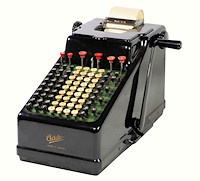 Addo Model 9-K, S/N A52405
Addo Model 9-K, S/N A52405
Manual, 9/10 columns, Sterling with farthings.
Body Dimensions: 160W x 340D x 205H
Weight: 8.8kg
Manufactured: Aktiebolaget Addo, Malmo, Sweden, from 1926.
This Addo Model 9-K is a full-keyboard machine for Sterling currency, with farthings (quarter-pence). The Model 9 keyboard has five decimal columns for pounds, three for shillings and pence, and one for the 10 and 11 pence keys and the three farthings keys. The seven function keys are (L to R) Repeat, Clear, Non-add, Subtract lock, Subtract, Sub-total, and Total. No keytop was ever provided for the small locking lever next to the subtraction key. The machine has direct subtraction, but shows negative totals as complements. The mechanism requires a "blank stroke" before taking a total. The cover is polished black Trolit with a gold Addo logo on the front and back. The model number is always visible on the paper tear-off bar, and the serial number is on the mechanism under the ribbon cover.
Addo 9-K keyboard.
Another 9-K keyboard with a different arrangement of the farthings keys.
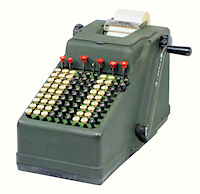 Addo Model 10-K, S/N A56869
Addo Model 10-K, S/N A56869
Manual, 9/10 columns, Sterling.
Body Dimensions: 160W x 340D x 205H
Weight: 8.9kg
Manufactured: Aktiebolaget Addo, Malmo, Sweden, from 1926.
The only difference in the Model 10 is that the keyboard has six decimal columns for pounds and three for shillings and pence. The 10 and 11 pence keys are "tacked on" at the extreme edge of the mechanism and operate through separate cut-outs in the cover. The cover is painted in a textured green with gold logos front and rear, but the front "Addo" has almost worn away.
 Addo Model N9, S/N F57528
Addo Model N9, S/N F57528
Manual, 9/10 columns, Sterling (converted)
Body Dimensions: 200W x 375D x 205H
Weight: 11.1kg
Manufactured: Addo Machine Co. Ltd., Cirencester, Glos., UK, 1950s.
Although Addo 10-key machines were available from 1936, the production of full-keyboard machines continued well into the 1950s. This was particularly so in England, where the full keyboard was considered more suitable for the non-decimal currency. This late-model N9 machine from Addo's British factory has a re-styled keyboard with rectangular keytops, and a new cast-aluminium cover replacing the fragile Trolit. The new cover improved the proportions of the machine with softer curves and an additional 20mm of empty space on all four sides. The actual calculating mechanism was not changed.
This machine was originally built for British currency with the same 9-column £/s/d layout as the Model 9 above. It was converted to 8-column all-decimal operation at the time of Australia's decimal currency changeover in February 1966. The ten-shillings column was converted to decimal, and the 10/11/farthings column was simply removed from both keyboard and printer. (The ribbon cover has been removed for the photograph to show the missing type carrier in the first numeric column). Only adding machines installed new during or after January 1955 were eligible for the Government-funded conversion program.
There is no sign of an Addo logo on this machine. The only external identification is the model number on the paper tear-off bar, and a small painted label from the Addo Machine Co. Ltd. on the rear. Some early British-made Addos have a label from the Agrell Machine Company, named after the Addo founder.
Addo Machine Co. Ltd. label on Model N9.
The first Addo-X ten-key machines were the Series 20 from 1936. These were built in a similar style to the full-keyboard machines, with Trolit casings and a choice of manual or electric operation. These are rare in Australia, largely because the full-keyboard machines were generally preferred for the non-decimal currency. The Series 20 continued until around 1949, when it was replaced by the Series 40 in streamlined metal casings. The Series 40 machines continued to develop during the 1950s and early 60s, until re-packaged into modern plastic casings in around 1965. These 10-key machines became much more popular with the change to decimal currency in 1966. The last Addo calculators were made around 1974.
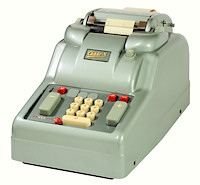 Addo-X Model 48E, S/N A90387
Addo-X Model 48E, S/N A90387
Manual, 10/11 columns, Sterling (converted).
Dimensions: 230W x 390D x 220H
Weight: 11.2kg
Manufactured: Aktiebolaget Addo, Malmo, Sweden, 1949-65 approx.
This Addo Series 40 Model 48E (E for Electric) was built in the late 1950s as a "ten-key" adding and subtracting machine for British currency. The streamlined cast-aluminium casing is finished in a distinctive metallic blue-green gloss. Model 48 performs direct subtraction, but shows negative balances as complements. A Model 348 was available with "true negative" totals.
This machine was converted to all-decimal operation during Australia's decimal currency changeover in 1966. The 10 and 11 (pence) keys were removed from the keyboard and replaced with plastic fillers, along with the associated function key. The internal changes to the mechanism were rather more extensive. Under the Government-funded conversion program, it was actually cheaper to replace a hand-cranked Model 48 with a new Model 331 (below) than to undertake the process of conversion.
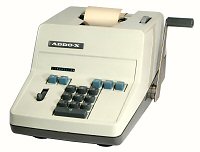 Addo-X Model 331, S/N 905231
Addo-X Model 331, S/N 905231
Manual, 10/11 columns
Dimensions: 190W x 310D x 150H
Weight: 5.1kg
Manufactured: Aktiebolaget Addo, Malmo, Sweden, 1965-72.
The Addo Model 331 is a compact hand-operated adding machine with direct subtraction. All the other 10-key machines shown here are based on the Series 40 mechanism from 1949. The Model 331 was introduced in 1965 with a new mechanism that was significantly smaller than the Series-40 machines, and only half the weight. Several different versions were available with different combinations of features. Many of these machines were installed as replacements for older British-currency machines during the decimal conversion in 1966.
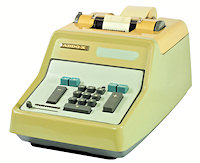 Addo-X Model 154-03-33, S/N 1601604
Addo-X Model 154-03-33, S/N 1601604
Electric, 10/11 columns,
Dimensions: 230W x 395D x 205H
Weight: 10.6kg
Manufactured: Addo Machine Co. Ltd., England, 1965-74 approx.
The Addo 154 is a motor-driven machine using the Series 40 mechanism, but in a light plastic rather than metal casing. It performs direct subtraction with true negative totals, and has separate function keys for positive or negative multiplication by repeated addition or subtraction. This machine was built in Addo's English factory.
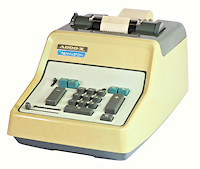 Addo-X Model 2383, S/N 1157867
Addo-X Model 2383, S/N 1157867
Electric, 12/13 columns
Dimensions: 230W x 395D x 205H
Weight: 12.6kg
Manufactured: Aktiebolaget Addo, Malmo, Sweden, 1968-74 approx.
This Addo-X Model 2383 is similar to the Model 154 above, but includes an automatic short-cut multiplier with separate X and = keys. It also includes a percentage function.
 Addo-X Model 4653, S/N 137596
Addo-X Model 4653, S/N 137596
Electric, 12/13 columns, dual register, full automatic
Dimensions: 250W x 400D x 215H
Weight: 16.1kg
Manufactured: Aktiebolaget Addo, Malmo, Sweden, 1965-67 approx.
The Addo 4653 is a substantial 4-function fully-automatic calculating machine. The 2-column keyboard at the left of the machine is used for positive or negative short-cut multiplication. The machine has a second selectable accumulator register, and a mechanism to allow printing of decimal points in any column. The cast-aluminium case is 20mm wider and has a deeper base to accommodate the extra mechanism.
A range of pinwheel calculators was designed by Addo engineers in the early 1940s to supplement their traditional adding machines, but they did not reach the market until about 1949. The machines were built by the Multo company, an Addo subsidiary based in the regional centre of Örkelljunga, about 80km from Addo's head office in Malmo.
While the Multo mechanism contains some very clever and ingenious features, it is obvious that the designers lacked the depth of experience of the major pinwheel manufacturers. The machines acquired something of a reputation for being unreliable and prone to jamming. This was most unfortunate, as a properly-adjusted Multo has a very light and responsive action and is a joy to use.
When the Addo company was absorbed into the Facit/Odhner group in 1966, the production of Multo machines was discontinued in favour of the long-established Odhner designs. Odhner machines were re-branded and repackaged as Multos for sale to Addo's traditional customers. Production of the Odhner-Multos ended around 1970.
Cover of a Multo instruction book for a re-branded Odhner 239.
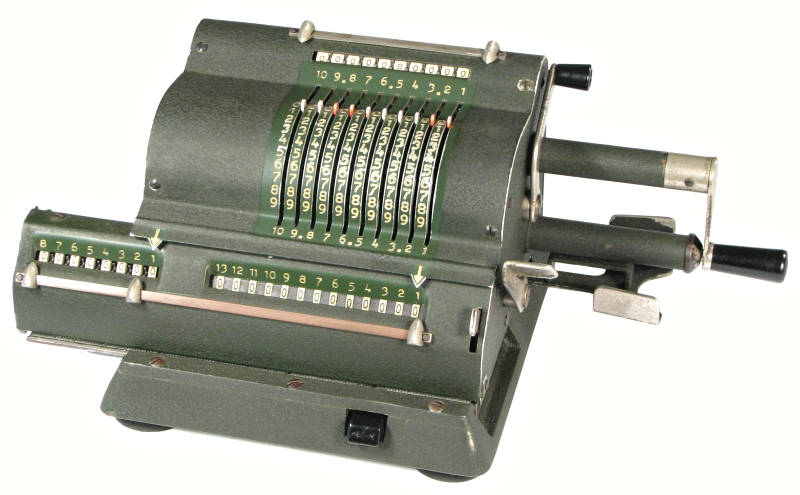 Multo Model 3, S/N 8145
Multo Model 3, S/N 8145
Digits: 10 rotor, 8 counter, 13 accumulator
Dimensions: Body 170W x 160D x 130H, overall width 310mm
Weight: 5.6 kg
Manufactured: Örkelljunga, Sweden, around 1950
The Multo machines were a clever design intended for single-handed operation, with all of the controls located on the right-hand side. There was no model for left-handed operators.
The rotor has ten setting rings on 7mm centres, with a check dial above and a quick-clearing lever to the right. The carriage has only one clearing lever, which normally clears both registers. Pressing the adjacent tab disconnects the accumulator and clears only the counter (as in setting up a division). It is not possible to clear only the accumulator.
The carriage is spring-loaded to the left, and is moved stepwise in either direction by a light touch of the lever under the winding handle. It can be released and run to the left by a push-button at the front of the baseplate, and can be pushed back to the right by hand whenever the machine is idle. The Model 3 is a basic machine with no tens-carry on the counter and no back-transfer mechanism.
The Multo machines are quite solidly built, with the base and right-hand end plate of cast iron. The pinwheels and check dials are of die-cast alloy, while the remainder of the mechanism (including the carriage frame) is of pressed metal. The external covers are of painted aluminium.
This early machine is finished in a textured green paint. It originally had a painted Multo logo in the area to the left of the setting rings, but the logo has not adhered well to the textured paint. These green machines often appear nameless, with only the model and serial number stamped on the underside of the base.
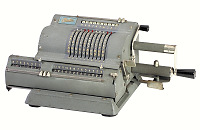 Multo Model 3, S/N 23212 (later version)
Multo Model 3, S/N 23212 (later version)
Digits: 10 rotor, 8 counter, 13 accumulator
Dimensions: Body 170W x 160D x 130H, overall width 310mm
Weight: 5.6 kg
Manufactured: Örkelljunga, Sweden, 1950s
Around S/N 20,000 the Multo machines received a number of minor updates. The colour changed from green to grey, with a moulded "Multo" name badge replacing the disappearing painted logo. The setting levers were colour-coded, and the main registers changed from black-on-white to white-on-black. The check dial remained black-on-white. The clearing control lever was made more user-friendly, and the carriage end covers were extended downwards to hide the roller mechanism underneath.
The only operational change was that the carriage release button on the front of the baseplate was replaced with a rocking "dome nut" control on the stop pillar near the winding handle.
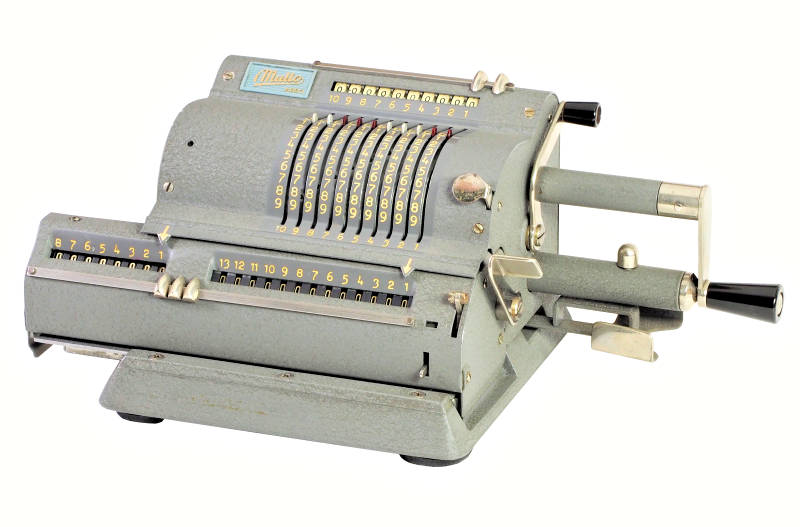 Multo Model 113, S/N 38540
Multo Model 113, S/N 38540
Digits: 10 rotor, 8 counter, 13 accumulator
Dimensions: Body 170W x 160D x 130H, overall width 310mm
Weight: 5.9 kg
Manufactured: Örkelljunga, Sweden, 1950s
This Multo Model 113 is a full-featured machine with a tens-carry mechanism and automatic reversing on the counter register, and a back-transfer mechanism from the accumulator to the rotor. The reversing mechanism has a tiny round window at the far left of the setting board which shows red when the counter is locked in reverse. The back-transfer mechanism is engaged by pressing the button to the right of the setting rings when the rotor clearing lever is pulled forward. A small red indicator appears at the right of the carriage when the back-transfer is engaged, and a lever below the indicator allows the mechanism to be released if the button was pressed accidentally.
This machine is finished in the mid-50s plain grey with a moulded Multo/Addo badge at the top left.
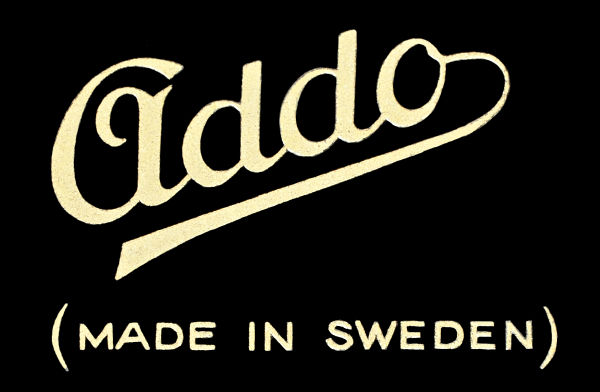 The "Addo" logo used on the full-keyboard machines,
with or without the "Made in Sweden".
The "Addo" logo used on the full-keyboard machines,
with or without the "Made in Sweden".
 An Agrell Machine Company nameplate from an early British-made Model 10.
An Agrell Machine Company nameplate from an early British-made Model 10.
 An Addo Machine Company label on a late-model N9.
An Addo Machine Company label on a late-model N9.
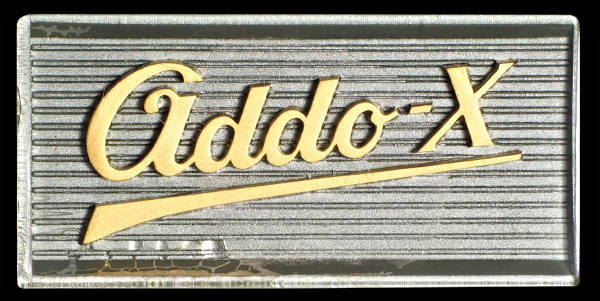 A moulded "Addo-X" badge used on the Model 48E.
A moulded "Addo-X" badge used on the Model 48E.
 The "Addo-X" badge used on the front of the later plastic-cased models.
The "Addo-X" badge used on the front of the later plastic-cased models.
 The "Addo" badge with individual letters,
used on the rear of the later models.
The "Addo" badge with individual letters,
used on the rear of the later models.
 The maker's nameplate from the British-made Addo-X Model 154.
The maker's nameplate from the British-made Addo-X Model 154.
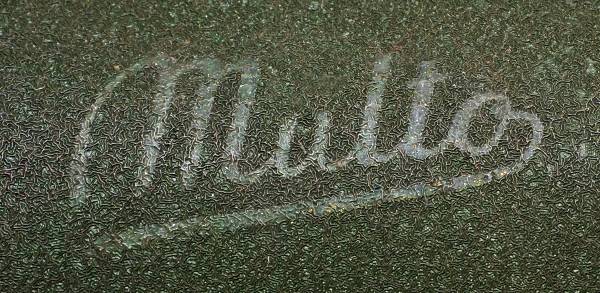 The painted script logo used on the early Multo machines has generally
not survived well on the textured green paint on the machine body. In
many cases the logo is now almost indistinguishable (except under
particular lighting directions), to the extent that the machines are
often mistaken as being nameless. This example from an early Multo 3
has been photographically enhanced. A similar "Addo" logo was used on the
green-painted full-keyboard machines, and has suffered a similar fate.
The painted script logo used on the early Multo machines has generally
not survived well on the textured green paint on the machine body. In
many cases the logo is now almost indistinguishable (except under
particular lighting directions), to the extent that the machines are
often mistaken as being nameless. This example from an early Multo 3
has been photographically enhanced. A similar "Addo" logo was used on the
green-painted full-keyboard machines, and has suffered a similar fate.
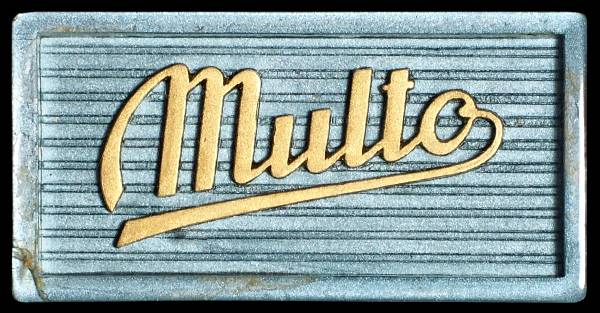 A moulded Multo badge used on the grey-painted machines
(around serial number 20,000).
A moulded Multo badge used on the grey-painted machines
(around serial number 20,000).
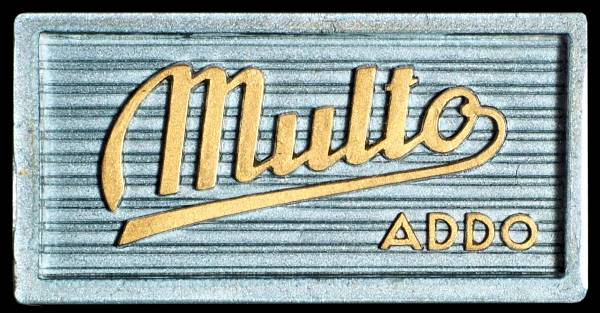 A later version of the moulded Multo badge which includes
the Addo name, from about serial number 40,000.
A later version of the moulded Multo badge which includes
the Addo name, from about serial number 40,000.
The Technical Section on this site has an illustrated description of the Multo 113 mechanism, and a step-by-step procedure for rebuilding the machine.
The Swedish Typewriter Page has further details of the Multo operation (in Swedish) and photos of the Multo factory in Örkelljunga.